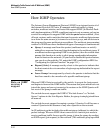
Multimedia Traffic Control with IP Multicast (IGMP)
How IGMP Operates
removing the IGMP group filter before the Querier has recognized the IGMP
leave. The Querier will continue to transmit the multicast group during this
short time, and because the group is no longer registered the switch will then
flood the multicast group to all ports.
On ProCurve switches that do support Data-Driven IGMP (“Smart” IGMP),
when unregistered multicasts are received the switch automatically filters
(drops) them. Thus, the sooner the IGMP Leave is processed, the sooner this
multicast traffic stops flowing.
Because of the multicast flooding problem mentioned above, the IGMP Fast-
Leave feature is disabled by default on all ProCurve switches that do not
support Data-Driven IGMP. (See the table above.) The feature can be enabled
on these switches via an SNMP set of this object:
hpSwitchIgmpPortForceLeaveState.<vid>.<port number>
However, this is not recommended as this will increase the amount of multi-
cast flooding during the period between the client’s IGMP Leave and the
Querier’s processing of that Leave. For more information on this topic refer
to “Forced Fast-Leave IGMP” on page page 2-17.
Automatic Fast-Leave Operation. If a switch port has the following char-
acteristics, then the Fast-Leave operation will apply:
1. Connected to only one end node
2. The end node currently belongs to a multicast group; i.e. is an IGMP client
3. The end node subsequently leaves the multicast group
Then the switch does not need to wait for the Querier status update interval,
but instead immediately removes the IGMP client from its IGMP table and
ceases transmitting IGMP traffic to the client. (If the switch detects multiple
end nodes on the port, automatic Fast-Leave does not activate—regardless of
whether one or more of these end nodes are IGMP clients.)
2-15


















